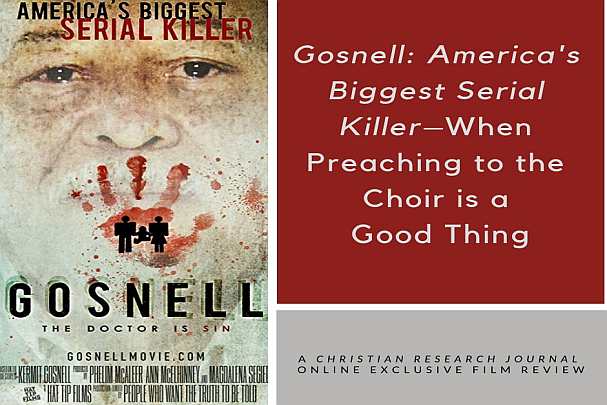A movie review of
Gosnell: The Trial of America’s Biggest Serial Killer
Directed by Nick Searcy
(Hat Tip Films, 2018)
(Rated PG-13, 2018)
God told Jeremiah to testify against child sacrifice even though the entire nation of Judah would ignore him.
You can forgive producers Phelim McAleera and Ann McElhinney for feeling a bit like the lonely prophet after their film Gosnell: The Trial of America’s Biggest Serial Killer opened to virtually no film industry reviews — good or bad.
They shouldn’t be surprised. The media did its best to ignore the actual trial of abortionist Kermit Gosnell until journalist Kirsten Powers and a lone blogger blew the case open. Before that, the state government ignored not only Gosnell’s clinic but also safety standards for abortion facilities statewide. Why not stay the course and ignore the movie, too? Indeed, an alternate subtitle for the movie might very well be Choosing Not to See.
Utterly Heinous. Kermit Gosnell owned and operated a gruesome abortion clinic in west Philadelphia. To say his clinic was filthy is kind of like saying arsenic tastes bad — true, but that doesn’t convey the half of it. The movie shows us unsanitary surgical instruments strewn about the procedure rooms. We see rotting food and bloody surgical fabrics sharing table space. Cat feces are everywhere. Maggots take up residence among the filth. You get sick just looking at the place. The stench is overwhelming.
What, exactly, is that smell? Here things get immeasurably worse. The smell is rotting fetal parts clogging up the toilets. More fetal remains are found in the refrigerator. We don’t see the grisly reality up close or for long periods of time, but we see enough severed body parts to know it’s bad.
Only, it’s worse than we ever imagined. Further investigation reveals Gosnell sometimes induced labor, delivered live babies, and then snipped their spinal cords. The babies weren’t the only victims. A woman also died inside the clinic. Others were badly injured. Assistants with zero medical training were paid under the table to sedate patients.
Gosnell got away with it for more than two decades. He had a little help from his friends. The state of Pennsylvania, under direction from pro-abortion Republican Governor Tom Ridge, told law enforcement to bug off the clinics. Subsequent governors played along. Indeed, when investigators finally showed up, they were looking for phony prescriptions — not real baby parts.
The film takes us all the way through Gosnell’s 2013 trial, where he is convicted of first-degree murder for intentionally killing three newborns. He was also convicted of involuntary manslaughter in the death of Karnamaya Mongar. He was sentenced to life in prison without the possibility of parole.
Telling the Truth. Gosnell is not a Christian film. There are no references to unborn humans bearing the image of God. Pro-life apologetics, outside the gruesome descriptions of Gosnell’s practice, are largely absent. We’re not sure where lead prosecutor Lexy McGuire (Sarah Jane Morris) stands on abortion, but she was convinced Gosnell “was killing babies” when he snipped their spinal cords. Detective James Wood (Dean Cain) is certainly sickened by what he finds at the clinic, but he delivers no pro-life sermons.
Instead, the strongest pro-life apologetic comes from a so-called “good” abortionist who testifies under oath that abortion isn’t the problem; Gosnell is. He practiced abortion all wrong. Unlike Gosnell, she and her team of late-term abortion doctors never get live births. Instead, they inject poison directly into the hearts of human fetuses and then dismember them inside. No live births are possible in a world where “good” abortion is practiced.
Anyone who thinks the good doctor’s testimony is pro-life propaganda would do well to consult Abortion Practice (Alpenglo Graphics, 1990) by Warren M. Hern, America’s leading late-term abortionist. His book is the standard medical text for teaching abortion procedures. Hern told a Planned Parenthood conference to man-up on abortion. “We have reached a point in this particular technology [dismemberment abortion] where there is no possibility of denying of an act of destruction. It is before one’s eyes. The sensations of dismemberment flow through the forceps like an electric current.”1
When asked what she would do if a fetus were born alive, the good abortionist replies that she would provide “comfort care” — meaning she’d keep the fetus warm and comfortable. “Eventually it will pass.” Gosnell’s attorney seizes the moment to drive home his point: “So basically you’d let it die? Seems like it’d be more humane to just take a pair of scissors…” He doesn’t need to finish the sentence. In short, why prosecute Gosnell for doing what every abortionist does? Don’t they all destroy unwanted fetuses? How they do it is irrelevant.
Hats off to the film for describing abortion truthfully. Nevertheless, one Christian reviewer complained the film “preaches only to the choir,” that is, to those of us already “pro-life.” Perhaps so, but the film has important lessons for the choir.
Compelling Takeaways. First, though the film is not as graphic as war movies such as Saving Private Ryan or Hacksaw Ridge (it’s rated PG-13 and appropriate for 8th grade and up), it nevertheless conveys an essential truth: pictures of injustice change the narrative. When jurors see a baby who was born alive and killed by Gosnell, the trial is essentially over. One by one, they stare at the image and look away. “When someone holds up a model of a six-month-old fetus and a pair of surgical scissors, we say ‘choice’ and we lose,” writes pro-abortion feminist Naomi Wolf.2 Pictures change how people feel about child killing. Facts and arguments change how they think. Both are vital in changing how they ultimately behave. Sure, we should use pictures wisely, but the film makes clear their essential purpose: they reawaken the moral intuitions of those who want the abortion issue to just go away. Gregg Cunningham puts it well: “When you show pictures of abortion, abortion protests itself.”
Second, pro-lifers must stay on message. In the film, Gosnell’s defenders throw the kitchen sink at the prosecution team. McGuire and Wood are told they hate poor women, that they’re racists and religious fanatics, and that they want Black women to suffer. Instead of meeting these attacks with promises to fix the underlying causes that allegedly drove poor women to Gosnell in the first place, they keep the main thing the main thing: Gosnell was killing babies. Everything else was secondary. Why, then, do pro-lifers start apologizing when critics tell us we’re not really pro-life unless we take up every injustice under the sun, such as poverty, gun violence, the treatment of refugees, and the opiate crisis — to name just a few? Set aside for the moment that pro-life pregnancy centers already provide resources for poor women and their children. It’s time we looked our critics in the eye and challenged their phony premise: “Let me see if I’ve got this straight: because I oppose the intentional killing of an innocent human being, I am responsible to fix everything wrong with society?” Is the American Cancer Society a fraud because it treats one disease and not many? Sure, as Christians, we will care about many issues. But it doesn’t follow that the operational objectives of the pro-life movement must be broad as well.
Third, worldviews matter. If you reject the premise that each and every human being has an equal right to life, you end up with someone like Gosnell. Idling beneath his abortion practice is a worldview known as body–self dualism. On body–self dualism, you are not your body. Rather, “you” are your thoughts, aims, desires, and awareness. Applied to human reproduction, body–self dualism says that a human organism was conceived but only later, after significant neurological development, did a “person” show up. Body–self dualism is problematic. If true, your mother has never hugged you, since one cannot hug desires, thoughts, and aims. You end up saying things like, “My body showed up before I did” or “I once was an embryo before my conscious self showed up.” The biblical worldview rejects body–self dualism. Humans are not ghosts in a machine but rather image bearers — a dynamic union of body and soul. Our bodies matter. If Christians are wrong about that, why not slice up fetal parts and toss them about your clinic?
But Gosnell serves another purpose. Maybe the choir is not as pro-life as the Christian reviewer thinks it is. Lots of Christians say they are pro-life, but they don’t believe their own rhetoric. Like Gosnell’s defenders, they are part of the cover-up. Do Christian conferences feature abortion presentations? How many seeker-driven megachurches touch the topic at all? Do major pastoral conferences raise the topic, ever?
I recently spoke at a large event for Christian university students. The event hosts refused to let me show a 55-second video depicting abortion as part of my presentation, despite acknowledging my history of using visuals responsibly. They applauded me for my practice of inviting people to look away and for stressing God’s grace to wounded people. They admitted that abortion pictures save lives. Nevertheless, organizers were convinced their students couldn’t handle the short clip, that special counselors would be needed, and that emotionally stricken young adults would overwhelm the staff.
Ironically, one of the event leaders who rejected my request for the video said he was on a personal mission to recruit more students for pro-life activism. How? By hiding the truth from them? When “pro-life” faculty are more concerned about the feelings of the born than they are the lives of the unborn, they are part of the problem. Maybe we need movies such as Gosnell to compel them not only to say abortion is wrong but to act like it.
Scott Klusendorf is president of Life Training Institute, where he trains pro-life advocates to persuasively defend their views. His book The Case for Life is published by Crossway.
NOTES
1 Warren M. Hern, M.D., and Billie Corrigan, R.N., “What About Us? Staff Reactions to the D & E Procedure,” paper presented at the Annual Meeting of the Association of Planned Parenthood Physicians, San Diego, California, October 26, 1978, in Advances in Planned Parenthood 15, 1 (1980), available at http://www.drhern.com/pdfs/staffrx.pdf.
2 Naomi Wolf, “Pro-Choice and Pro-Life,” The New York Times, April 3, 1997.









